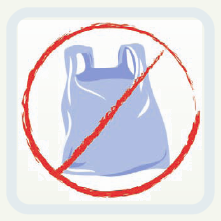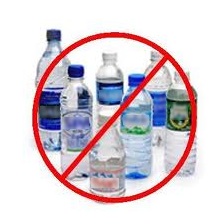

Helping People Address Their Problems with Plastic
& To Be Kinder To the Environment
credits and disclaimer


| The Plastic Problem & The
Environment
Discarded plastic bags clogging up drains, entangled in fences and entangled in brush. Plastic bottles in gutters, yards, fields and beaches. Plastic in various forms strangling fish and wildlife, or found in the bellies of fish and wildlife. Yuck. When used properly, plastic is a wonderful thing: it's made many things in our life much more convenient and sanitary. Unfortunately, people think of plastic as disposable rather than reusable or recyclable, and discarded plastic is not only ugly on the landscape, it's also harmful, as we see in the massive garbage flows in the ocean, dead animals that have choked to death or suffocated because of plastic, plastic found inside our own bodies, and reports of toxic substances released into Earth and water from discarded plastic. Plastic is causing huge environmental problems. In developing countries, discarded plastic bags and bottles are a particular problem: on a trip to Romania in 2008, the amount of trash along the roads, in fields and even on the beach was staggering to me. As a tourist, it made me want to move through certain regions quickly -- no desire to stay and spend my money on food, accommodations or museum entry fees in an environment that looked so bad. Imagine if I had been a potential investor in the country, looking to start a hotel; one look at some of the landscape and I would have decided against investing my money there. But it's not a problem limited to developing countries; ever been to Naples, Italy? More resources on why discarded plastic is bad for the environment and people
Plastic Not-So-Fantastic: How the Versatile Material Harms the Environment and Human Health The Effects of Bottled Water on the Environment
Addressing the problem of discarded plastic in a developing country can:
The first goal is to clearly illustrate that the problem of discarded plastic is pervasive in a particular region. Nothing does this better than photos and field visits. Take lots and lots of photos that illustrate the problem of discarded plastic. Encourage local people to submit their own photos (easily done with cell phones). All photos should have a location name and date. Post these photos on a web site of your own and an account on Flickr (create a group on Flickr specifically for these photos from your region or country). See if the government or any NGOs working in the area have reports on the problems of waste management in your area; you do this by contacting agencies directly, searching on the Internet, and contacting a local university library to see if they can help you find such research. Quote from these reports on your web site to support your message that discarded plastic is a problem in a particular village, region or country. Illustrate the life-cycle of plastic, specifically on how long it takes to degrade in the environment, and why this is a problem. If you can convince people that discarded plastic is a problem, you will have an easier time of getting them to recycle and reuse plastic, or to seek more environmentally-friendly alternatives to plastic. Getting People to Change Their Ways Your goal is to get people to change their ways regarding how they use and discard plastic, particularly plastic bags and plastic bottles. Your goal is to get more people to recycle and reuse plastic, and to seek more environmentally-friendly alternatives to plastic. You get your environmental message out via:
Changing people's ways is easier said than done! Some things you want to encourage people to do regarding recycling and reusing plastic, and regarding seeking more environmentally-friendly alternatives to plastic:
Show Results Showcase how people take your ideas and incorporate them into their lives. Take photos of their work and put it on your own Flickr site or web site. Encourage the press to cover the results of your efforts. Send a press release to local government officials talking about the results of your efforts. Show photos of these results at your public presentations.
Creating or Holding a Successful Community Event or Fund Raising Event. Fund Raising For a Cause or Organization How to Make a Difference Internationally/Globally/in Another Country Without Going Abroad How you can advocate for an issue important to you Details on volunteering abroad (volunteering internationally). Ideas for Funding Your Volunteering Abroad Trip. Volunteering To Help After Major Disasters. How to Find Volunteering Opportunities, a resource for adults who want to volunteer Family Volunteer - Volunteering by Families with Children. Ideas for Leadership Volunteering
Activities and Girl Scouts Gold Awards Donating Things Instead of Cash or Time (In-Kind Contributions) How to Get a Job with the United Nations or Other International Humanitarian or Development Organization Detailed information on Finding Community Service and Volunteering for Teens. Detailed advice for volunteer groups / group volunteering. Careers Working With Animals (for the benefit of animals)
© 2017 by Jayne Cravens, all rights reserved. No part of this material can be reproduced in print or in electronic form without express written permission by Jayne Cravens.
|
|
 Home page for those that want to help
Home page for those that want to help Home page for this entire web site,
coyotebroad.com / coyotecommunications.com
Home page for this entire web site,
coyotebroad.com / coyotecommunications.com my
consulting services & my
workshops & presentations
my
consulting services & my
workshops & presentations my
credentials & expertise
my
credentials & expertise My
research projects
My
research projects My book: The Last Virtual
Volunteering Guidebook
My book: The Last Virtual
Volunteering Guidebook contact
me or see
my schedule
contact
me or see
my schedule Jayne's
My
Thrift Book Wish list (gently used books - I prefer this
to Amazon) & my
Amazon Wishlist
Jayne's
My
Thrift Book Wish list (gently used books - I prefer this
to Amazon) & my
Amazon Wishlist
See my web site's privacy policy.
Credits & Copyright
© 2010-2024 by Jayne
Cravens, all rights reserved. No part of this material
can be reproduced in print or in electronic form without
express written permission by Jayne Cravens.
Please contact me for permission to reprint, present or distribute these materials.